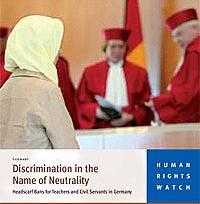A Stockholm woman has reported an adult education college in Spånga to the Equality Ombudsman (DO) after being told that she could not wear an Islamic headscarf in class.
The woman was told on January 15th that she was no longer welcome at Västerort Vuxengymnasium, an adult education college in Spånga, if she persisted in wearing her. The woman has now reported the matter to the Equality Ombudsman (DO) alleging discrimination.
In her report to DO dated January 20th, the woman alleges that she was told that she could not wear her niqab in class or in contact with the school’s staff. The woman explains that the school justified its decision by referring to a recent decision by the National Agency for Education Skolverket) which banned the wearing of some Muslim headscarves in class.
“But this is just a ruling, it is not a law and the ruling concerns those who wear a burqa, covering the whole face. I have a niqab which shows the area around the eyes,” the woman argued. The woman writes that she finds it “offensive” to be expelled for her “personal style” and argues that the ruling is confusing as some schools permit the niqab.
But the college’s rector, Britt-Marie Johansson, has defended the school’s right to exclude the student from classes, referring to the education agency’s ruling. “At Västerorts vux it is not allowed in the classroom to cover one’s face, with a veil or similar. This rule also applies in contact with staff. This means that neither a niqab nor a burqa can be worn.” According to Johansson, the choice facing students is thus clear. “Accept the rules stated above or discontinue your studies.”
But the student is keen to continue her studies and claims that she has offered the school a compromise. “I have said that I can sit at the front of the class, and remove the niqab during classes and to identify myself. I have even spoken to the men in the class … and they have said that it doesn’t bother them.”
The student argues that freedom of religion is enshrined in law in Sweden and this should take precedence over the education agency ruling.
The Local, 12 February 2010

 Muslim students have held demonstrations in Paris on the fifth anniversary of the banning of the Muslim headscarf in French schools.
Muslim students have held demonstrations in Paris on the fifth anniversary of the banning of the Muslim headscarf in French schools. A Muslim woman was asked to leave her place in line at a credit union in Southern Maryland and be served in a back room because the head scarf she wore for religious reasons violated the institution’s “no hats, hoods or sunglasses” policy, the woman said yesterday.
A Muslim woman was asked to leave her place in line at a credit union in Southern Maryland and be served in a back room because the head scarf she wore for religious reasons violated the institution’s “no hats, hoods or sunglasses” policy, the woman said yesterday. German state bans on religious symbols and clothing for teachers and other civil servants discriminate against Muslim women who wear the headscarf, Human Rights Watch said in a report released today.
German state bans on religious symbols and clothing for teachers and other civil servants discriminate against Muslim women who wear the headscarf, Human Rights Watch said in a report released today.